 Scientists at Penn State University have made a giant leap, or should that be a slow lumber, forward in genetic research by sequencing the genome of the woolly mammoth. The team sequenced four billion bases, or letters, of DNA using the latest technology, and a new approach to read very old DNA - they also did it relatively cheaply. This is 100 times more data than for any other extinct species, although only around three and a half billion are actually mammoth, while the rest probably belong to contaminating bacteria or fungi. The researchers think the mammoth's genome is about the same size as that of the modern-day African elephant, which they used to figure out which of the DNA letters were likely to be mammoth, and which were contamination.
Scientists at Penn State University have made a giant leap, or should that be a slow lumber, forward in genetic research by sequencing the genome of the woolly mammoth. The team sequenced four billion bases, or letters, of DNA using the latest technology, and a new approach to read very old DNA - they also did it relatively cheaply. This is 100 times more data than for any other extinct species, although only around three and a half billion are actually mammoth, while the rest probably belong to contaminating bacteria or fungi. The researchers think the mammoth's genome is about the same size as that of the modern-day African elephant, which they used to figure out which of the DNA letters were likely to be mammoth, and which were contamination.
The scientists used DNA extracted from hair taken from a mammoth mummy that had been buried in the Siberian permafrost for 20,000 years, and another mummy that was 60,000 years old. The team used hair to try and avoid contamination problems, as it's easier to remove bacteria and fungi from hair than flesh. And hair also preserves the structure of ancient DNA better than bones, as the sturdy hair proteins encase and protect the DNA almost like plastic wrap.
By comparing the mammoth sequence to that of modern-day elephants, the researchers think that mammoths and their modern relatives separated around six-million years ago, about the same time that humans and chimpanzees separated. But unlike humans and chimps, which relatively rapidly evolved into two distinct species, mammoths and elephants evolved at a more gradual pace.
The team also found that woolly mammoths had a relatively low genetic diversity, meaning that all animals are quite similar, even those that were older. The data could also explain why mammoths went extinct - which might be useful to help currently surviving species that are on the brink of extinction. The researchers are also hoping to find the genes that could explain how mammoths survived in such cold environments. And it's another step on the way to potentially bring the woolly mammoth back to life, especially after the recent successes in cloning a mouse that had been frozen.
Reference: Miller, W et al (2008). Sequencing the nuclear genome of the extinct woolly mammoth Nature, 456 (7220), 387-390
- Previous Indigo could help psoriasis
- Next Switchable surfactants










Comments
Add a comment